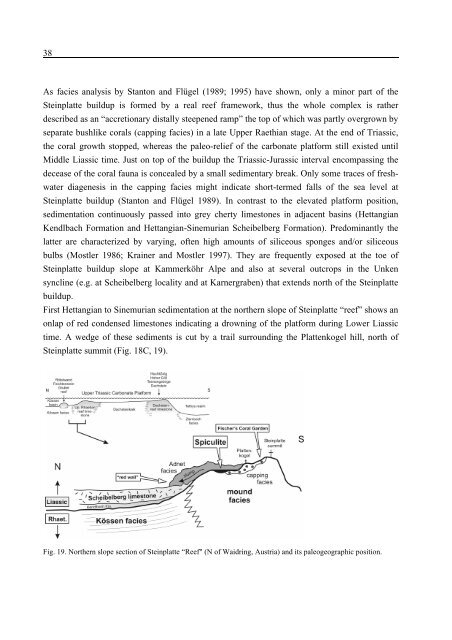Porifera-microbialites of the Lower Liassic (Northern Calcareous ...
Porifera-microbialites of the Lower Liassic (Northern Calcareous ...
Porifera-microbialites of the Lower Liassic (Northern Calcareous ...
Create successful ePaper yourself
Turn your PDF publications into a flip-book with our unique Google optimized e-Paper software.
38<br />
As facies analysis by Stanton and Flügel (1989; 1995) have shown, only a minor part <strong>of</strong> <strong>the</strong><br />
Steinplatte buildup is formed by a real reef framework, thus <strong>the</strong> whole complex is ra<strong>the</strong>r<br />
described as an “accretionary distally steepened ramp” <strong>the</strong> top <strong>of</strong> which was partly overgrown by<br />
separate bushlike corals (capping facies) in a late Upper Raethian stage. At <strong>the</strong> end <strong>of</strong> Triassic,<br />
<strong>the</strong> coral growth stopped, whereas <strong>the</strong> paleo-relief <strong>of</strong> <strong>the</strong> carbonate platform still existed until<br />
Middle <strong>Liassic</strong> time. Just on top <strong>of</strong> <strong>the</strong> buildup <strong>the</strong> Triassic-Jurassic interval encompassing <strong>the</strong><br />
decease <strong>of</strong> <strong>the</strong> coral fauna is concealed by a small sedimentary break. Only some traces <strong>of</strong> fresh-<br />
water diagenesis in <strong>the</strong> capping facies might indicate short-termed falls <strong>of</strong> <strong>the</strong> sea level at<br />
Steinplatte buildup (Stanton and Flügel 1989). In contrast to <strong>the</strong> elevated platform position,<br />
sedimentation continuously passed into grey cherty limestones in adjacent basins (Hettangian<br />
Kendlbach Formation and Hettangian-Sinemurian Scheibelberg Formation). Predominantly <strong>the</strong><br />
latter are characterized by varying, <strong>of</strong>ten high amounts <strong>of</strong> siliceous sponges and/or siliceous<br />
bulbs (Mostler 1986; Krainer and Mostler 1997). They are frequently exposed at <strong>the</strong> toe <strong>of</strong><br />
Steinplatte buildup slope at Kammerköhr Alpe and also at several outcrops in <strong>the</strong> Unken<br />
syncline (e.g. at Scheibelberg locality and at Karnergraben) that extends north <strong>of</strong> <strong>the</strong> Steinplatte<br />
buildup.<br />
First Hettangian to Sinemurian sedimentation at <strong>the</strong> nor<strong>the</strong>rn slope <strong>of</strong> Steinplatte “reef” shows an<br />
onlap <strong>of</strong> red condensed limestones indicating a drowning <strong>of</strong> <strong>the</strong> platform during <strong>Lower</strong> <strong>Liassic</strong><br />
time. A wedge <strong>of</strong> <strong>the</strong>se sediments is cut by a trail surrounding <strong>the</strong> Plattenkogel hill, north <strong>of</strong><br />
Steinplatte summit (Fig. 18C, 19).<br />
Fig. 19. Nor<strong>the</strong>rn slope section <strong>of</strong> Steinplatte “Reef" (N <strong>of</strong> Waidring, Austria) and its paleogeographic position.

















